Chinese Music
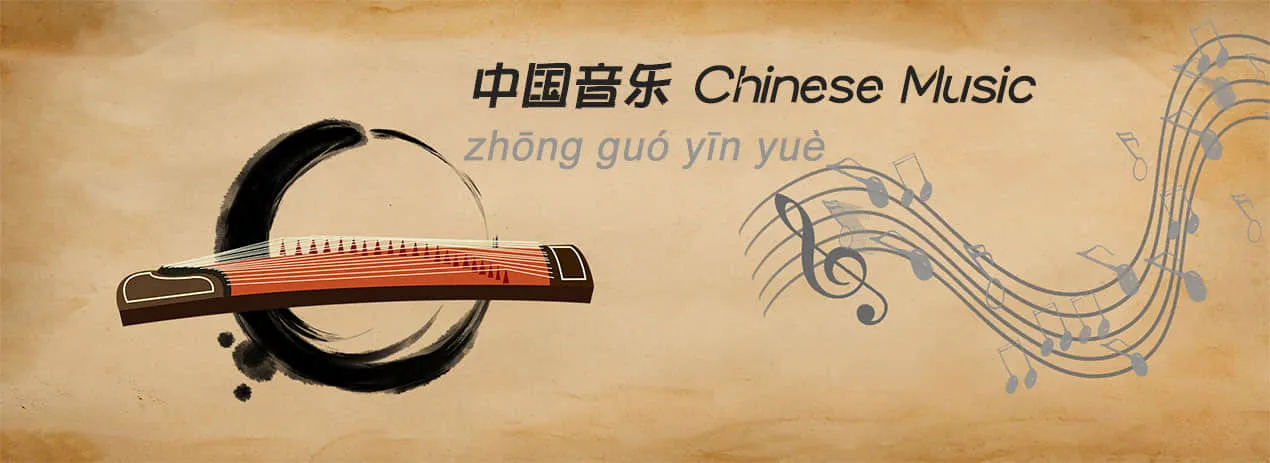
Throughout the long history of China, the Chinese people have been creating music to meet their complex cultural needs. In the process of development, Chinese music has had a far-reaching influence on adjoining regions, and has absorbed musical elements from neighbors. We will explore this musical history and development, instruments and genres, regional variations and contemporary Chinese music.
Learn About Chinese Music
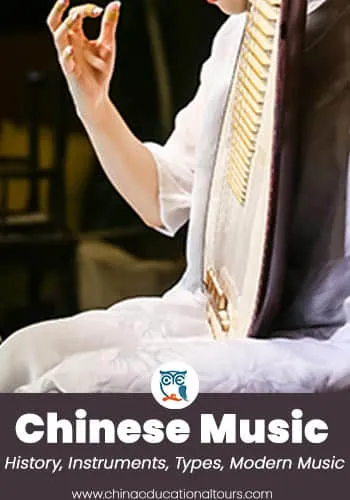
History
Early history – (from 8000 to 500 BC)
 The ancient chime bells produce melodious tune.
The ancient chime bells produce melodious tune.
Music began in China 1000’s of years ago as evidenced by excavations in Henan uncovering bone flutes dating back 8,000 years, and clay music instruments in Xi'an dating back 6,000 years.
The Zhou Dynasty (10th to 7th century BC), established a formal system of court and ceremonial music (later called “Yayue” - meaning "elegant music") which embraced the concept of music as a cosmological manifestation of sounds found in nature and integrated into the dual universal order of yin and yang. "Correct" music in the Zhou concept involved instruments connecting the five elements of nature (water, fire, earth, air, and space/emptiness) and bringing harmony to nature. During this time, Chinese music established a foundation built on the 5-pitch pentatonic scale and was in fact derived from the musical concept “Cycle-of-Fifths theory”.
Chinese philosophers approached music differently. Confucius believed that “correct” music was important for the growth and civil refinement of the individual. The entire Confucian philosophical system considers formal “Yayue” music to be morally uplifting and a symbol of a good ruler and stable government while other popular, non-Yayue, forms of music were considered to be a corrupting influence. Another famous Chinese philosopher, Mozi, condemned music and argued that it was an extravagance and indulgence that served no usefulness for society and may actually be harmful.
Qin to Qing dynasty – (from 500 BC to 1900 AD)
Other Asian instruments and musical styles – such as the erhu and the pipa from Central Asia and the Heptatonic scale from India – were introduced in subsequent dynasties (although the heptatonic scale was later abandoned in China). The uber-famous Chinese instrument, the Qin, became famous during the Tang Dynasty (618-907 AD), while European music arrived in China as early as 1601 when a harpsichord was given to the Ming imperial court by a visiting Jesuit priest, who also trained several eunuchs to play it.
The Republic of China (1912–1949)
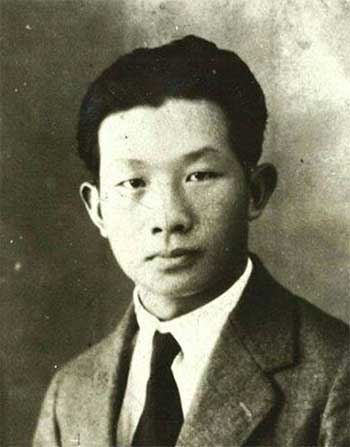
Nie Er, a Chinese composer best known for "March of the Volunteers"
Symphony orchestras played songs in the concert halls of big cities and on the newly invented radio for audience. . Some musicians added jazz influences to traditional music, through the addition of xylophones, saxophones and string instruments, among other instruments.In Shanghai, a popular music genre called Shidaiqu emerged in the 1920s, which mixed Chinese and Western popular music. It led the style of Chinese music industry for three decades.
In the 1940s, a large-scale campaign was initiated in the Communist controlled areas of the country to use folk music to create revolutionary songs and through those songs, educate the largely illiterate rural population about the party. The East Is Red is an example from northern Shaanxi and was adapted into a nationalist hymn. However, in a telling sign of the times to come, music regarded as superstitious or anti-revolutionary was banned or restricted.
1949 – 1990s
The golden age of Shidaiqu came to an end when the Communist Party denounced Chinese popular music as “yellow music” (loosely translated to ‘pornography’) because Maoists believed that pop music represented the decline of Chinese society. In 1949, after the Kuomintang relocated to Taiwan and the People's Republic of China (PRC) was established, the art of music has been flourishing with a hundred flowers in diversified development. Excellent music works of different styles are constantly emerging, showing and exerting positive influence at corresponding stages, jointly enriching people's spiritual and cultural life and promoting the continuous progress of cultural undertakings. At the same time, the Chinese government has been actively encouraging and supporting the creation and dissemination of all kinds of excellent music that is positive, healthy, full of positive energy and that reflects the national culture and the spirit of the Times.
In 1989, a new “Northwest Wind” style of music with a fast tempo became popular among some groups of protesters and this music developed into Chinese rock, which gained popularity in the 90s. However, the government did not support this new form of music and thus limited the exposure and airtime of the Chinese rock genre.
Types/Styles of Music

A Girl is playing the Guzheng.
There are many ways to categorize Chinese music, but in a general sense, it can be divided into Folk Music and Opera. While both genres will sound vastly different from music produced in the West, Chinese folk music is somewhat similar to Western folk music as both can evoke the flavor of local culture and have a great degree of focus on instrumentation instead of voice and lyrics. Chinese opera, likewise, is similar to Western opera in that it’s largely focused on vocalization with light instrumental accompaniment – the voice truly takes center stage, although the overall style and sound of Chinese opera are vastly different.
Neither form is popular today and is found in only selected areas of society – Chinese opera is still performed across the country but does not attract the same following as modern music. Folk music is played at weddings and funerals. Occasional concerts are performed nationwide, and it can still be heard coming from the homes of elder citizens, but it’s rarely found with the frequency and ubiquity of modern music.
Chinese music was originally designed to produce a soothing effect on society, making people more harmonious by reducing conflict and increasing obedience. Therefore, the music is not meant to be danced or moved to, which means there is much less focus on rhythm and beat. Instead, it has a smooth, continuous nature effortlessly flowing from sound to sound without sharp breaks in tempo and usually accelerating in tempo towards the end. There have been analogies made between Chinese music and water in mountain streams which gradually grows bigger and faster as it flows downstream.
Folk Music
Usually played in ensembles or by large orchestras in the same way European “Classical music” has traditionally been played.
Chinese Musical Instruments
For many people unfamiliar with Chinese music, one of the most fascinating aspects is the extensive variety of unique instruments. Most of the instruments used in traditional Chinese music are only found in Asian music, and some of them are exclusive to China. The shapes and forms of many instruments are unlike anything found in Western culture and the sounds they produce are likewise hard, if not impossible, to replicate on Western instruments. In short, entering the world of traditional Chinese music is like entering a completely different musical world.
Bamboo pipes and the qin are some of the oldest known Chinese musical instruments. Musical instruments are divided into eight categories known as “bayin”. Traditional music in China is played on solo instruments or in small groups of stringed instruments, flutes, and different cymbals, gongs, and drums. Instruments are classified according to their materials of composition: animal skins, gourd, bamboo, wood, silk, earth/clay, metal, and stone.
Chinese music is performed on the Pentatonic scale (based on 5 tones), which is different from Western music that is Heptatonic (based on 7 tones). This is a major difference between Western and Eastern music and gives Eastern music a distinct, high-pitched sound. Chinese orchestras mainly use woodwinds, percussion, bowed strings, and plucked/struck strings.
Chinese orchestras mainly use woodwinds, percussion, bowed strings, and plucked/struck strings.
Woodwind
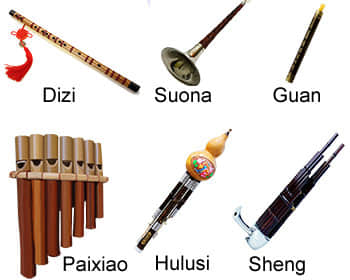
There are around 15 different woodwind instruments in China, which mainly refer to bamboo instruments. The more popular are: dizi, suona, guan, paixiao, hulusi, sheng.
Dizi – bamboo flute with membrane.
Suona – double-reed wind instrument with a wide metal bell at end.
Guan – cylindrical double-reed wind instrument made of either hardwood or bamboo.
Paixiao – pan pipes.
Hulusi – free-reed wind instrument with three bamboo pipes inserted through a gourd wind chest; one pipe has finger holes and the other two are drone pipes.
Sheng – free reed mouth organ made with bamboo pipes inserted into a chamber with finger holes.
Percussion
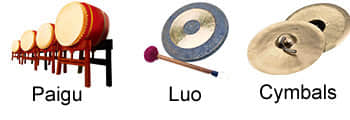
There are a mind-boggling over 75 different percussion instruments in Chinese music. They take the form of wood, stone, metal, skin, clay, and even gourd. A few of the more popular are: paigu, gong, cymbals.
Paigu – set of three to seven drums played with sticks.
Luo – a flat, circular metal disc which is hit with a mallet.
Cymbals – slightly concave round brass plates that are either struck against another one or struck with a stick to make a ringing or clashing sound.
Bowed strings
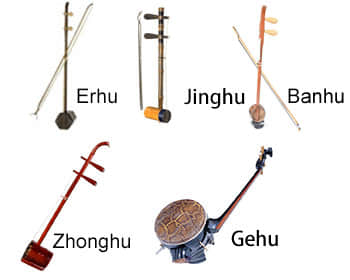
There are almost 50 different bowed stringed instruments in China. The more popular are: erhu, zhonghu, banhu, jinghu, gehu..
Erhu – two stringed fiddle.
Zhonghu – low pitched two-stringed fiddle.
Banhu – two-stringed fiddle with a coconut resonator and wooden face.
Jinghu – high pitched two-stringed fiddle.
Gehu – four-stringed, cello-like bass instrument.
Plucked and struck strings
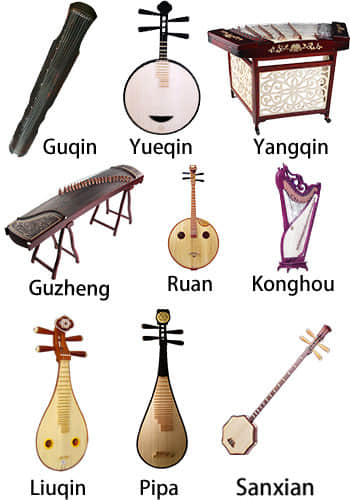
There are over 20 different plucked or struck stringed instruments in China, but the more popular are: guqin, yueqin, yangqin, guzheng, ruan, konghou, liuqin, pipa, zhu, sanxian.
Guqin – 7-stringed zithers
Yueqin – plucked lute with a wooden body, a short-fretted neck, and four strings tuned in pairs
Yangqin – hammered dulcimer
Guzheng – 16–26 stringed zither with movable bridges
Ruan – moon-shaped lute in five sizes
Konghou – harp
Liuqin – small plucked lute, fretted with a pear-shaped body and four strings
Pipa – pear-shaped fretted lute with 4 to 5 strings
Zhu – a zither similar to a guzheng but it's played with a bamboo mallet
Sanxian – plucked lute with snakeskin covered body with and long fretless neck
Opera
There are many kinds of Chinese opera that are related to different geographic regions and each have a distinct flavor and style. However, to the untrained ear, each type will sound strikingly similar and in fact, all Chinese operatic styles do share many overall traits. They all tend to focus on a high-pitched female voice, elaborate costumes adorned with masks or full-face makeup (usually with accentuated eye and lip color), and ornate headpieces. For a more detailed, comprehensive article on Chinese opera
Varieties
Several different local variations of Chinese opera are: Beijing opera, Cantonese opera, Shaoxing opera, Sichuan opera, Kunqu, Pingju, Qinqiang, Lüju.
Costumes and Makeup
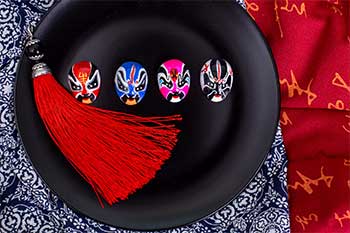
Beijing opera facial masks
Two classic characteristics of all forms of Chinese opera are the visual elements of costumes and makeup. The exaggerated face paints are meant to scare away the enemy and each color has a different meaning. They symbolize a character's role, fate, and also help illustrate the character's emotional state and general character. Makeup can include a completely painted face or only painted in the center connecting the eyes and the nose.
White – perhaps surprising to observers in the West, white does not carry the traditionally western meaning of purity, innocence, and good. Instead, it represents something evil, treacherous, and sinister. White painted faces usually represent the villain of the show. The larger the white painted area, the crueler the character.
Green – signifies impulsiveness, violence, and a lack self-control.
Red – indicates bravery or loyalty.
Black – represents brashness, ferocity, or fairness.
Yellow – stands for ambition, fierceness, or intelligence.
Blue – symbolizes steadfastness (loyalty plus tenacity).
Pink – signifies sophistication and calmness.
Gold or Silver – denotes mysteriousness.
Physical Actions
Another unique characteristic, especially to an operatic art form, is the amount and integration of physically challenging, acrobatic moves incorporated into the performance. Chinese opera performances include “flying”/“spinning in the air” (high-flying trapeze-like stunts or ground-level gymnastic maneuvers), tumbles, flips, summersaults, intricate balancing movements, martial art feats, and even fire-spitting – none of which would be normally found in western opera.
Different Cultures / Regional
China has many ethnic minorities living amongst the majority Han culture – making up about 90% of China’s population today. The other 10% are divided among 100s of other ethnicities, the largest groups being Tibetans, Uyghurs, Manchus, Zhuang, Dai, Mongolians, Naxi, Miao, Wa, Yi, and Lisu.
Cantonese
While perhaps not considered a true ethnicity, Cantonese people do speak their own language, have their own cuisine, and their own heritage different from the Han. Included in that heritage is unique art and music, the latter of which is usually much livelier in pace and happier in tone and spirit than music from other provinces – which is typical of Cantonese character. In Guangdong, two traditional genres of music are Teochew and Hakka, but there are many more.
Yunnan
An area in south/southwest China containing dozens of ethnic minorities (including the Dai, Dong, and Li); all of whom have distinct musical styles. Much of the music in Yunnan is somewhat similar to other music found in South East Asian countries like Myanmar and Thailand; however, some of the music is similar to forms found in southern China.
Kuaiban
A type of rhythmic talking/singing from the Shandong province performed with percussive instruments such as a clapper called a Paiban. Kuaiban is similar to rap and other forms of rhythmic music found in other cultures.
Tibetan
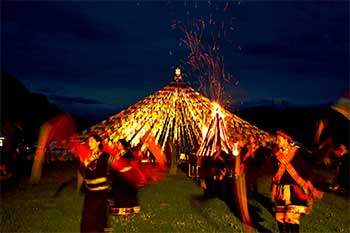
Tibetans are good at dancing and singing
Of all the forms of music found within China, perhaps the music from Tibet is the most well known in most Western countries. Tibetan monks’ chanting and the deep bass of their long “dungchen” horn have found themselves in many mainstream western artists’ music.
Monks use music to recite various sacred texts and for festival celebrations. Music is divided into “Chants” and “Music”.
Chants
There are several forms of Tibetan chants:
1) Yang – a very specialized form without metrical timing, dominated by resonant drums and sustained, low syllables.
2) Gelugpa – a more restrained, classical form that is perhaps the most popular.
3) Nyingmapa – a somewhat romantic and dramatic form.
Music
There are many forms of Tibetan music: the operatic “Lhamo”, the highly rhythmic “Nangma” and “Toshe”, and the classic “Gar”.
Tibetan Instruments
Long Horn – called a Dungchen with a low-pitched bass sound
Bells – different sizes produce notes from high to low pitch
“Singing” Bowls – different sizes produce varying notes, but mostly high, or very high, pitched. Considered relaxing, these bowls are often found in meditation music both within and outside of Tibet.
Damaru – double faced drum played by twirling/rolling it back and forth causing balls tied to two side strings to strike the drum faces producing a high-pitched sound.
Dramyin – six string guitar/lute which produces mostly high-pitched notes comparable to a banjo.
Gyaling – a trumpet producing high-pitched notes which often are vibrated.
Lag-na – a framed drum on a wooden stick, struck with a mallet producing a medium-pitched sound.
Tingsha/Shang – small hand-held cymbals which produce a very high note.
Xinjiang
An autonomous region dominated by a Turkic people called Uyghurs (pronounced “wigger”) which has a culture similar to other Turkic groups from Central Asia. The Uyghurs' best-known musical form is the Muqam, a symphony-type suite of twelve sections related to Uzbek and Tajik forms and built on a seven-note scale. Instruments typically include dap (a drum), dulcimers, fiddles and lutes and the musicians have some freedom for personal accompaniment, especially in the percussion.
Inner Mongolia
The Mongolian culture within China is somewhat similar to that in the country of Mongolia. Mongolian folk songs have a "long tune" and a "short tune" and use a variety of stringed instruments such as Morin Khuur (a type of fiddle).
Modern Chinese Music
National / Revolutionary

An ideological music with political or nationalistic content, sometimes adapted to a grand orchestral presentation. Created in the early to mid-20th century, this became the leading music genre on radio and television after the Communist party came to power until the 1980s. During the height of the Cultural Revolution, political music was the most prevalent style and became known as Revolutionary Music with a near cult status under pro-Communist ideology.
(Note: a major, important difference in the following three music genres from the West is the heavy governmental influence and censorship on which topics/subjects artists can and cannot cover. As a result, subjects tend to be less about sex, violence, societal hardships, politics, or any kind of rebellious natured topic and instead lean more towards love, societal harmony, or whimsical fun topics lacking in deep meaning – American 50’s doo-wop could be considered similar).
Pop
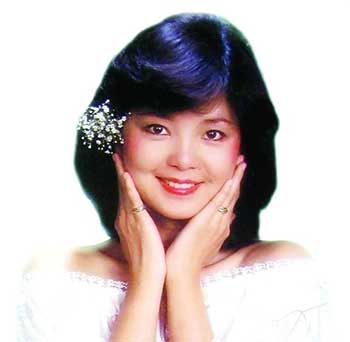
Teresa Teng:Famous Chinese pop star
This category can also be called C-pop, Cantopop, or Mandopop. For reference, pop music from Korea and Japan are referred to as K-pop and J-pop respectively. Music can be sung in either Mandarin or Cantonese. A large percent of C-pop music comes from Hong Kong or Taiwan, with a smaller percent coming from Singapore, Malaysia, or mainland China.
From a musical and songwriting perspective, Chinese pop music is generally described as quite simple. Structurally, Chinese songs carry a basic verse-chorus-(sometimes) bridge arrangement. Extended intros, outros, or 5-minute guitar solos are rare. Stylistically, they are mostly ballad style with some variance in tempo and arrangements to keep music more modern. There has recently been some R&B influence from Taiwan and Korea, but apart from that, songs are based on simple arrangements at a moderate speed with exceedingly little rap, heavy drums, or distorted guitar riffs. Harmonically, Chinese music is mostly simple basic chords, major and minor. Artists rarely make key changes within a song as this may sound strange to the artist and/or listener. Chinese pop music tends to be harmonically simple because the focus is usually on the melody first. Unlike classical music in the West, which has a tradition of theoretical and practical application of harmony, Chinese music focuses on the inventiveness and expression in a single melody as the instrumentation and mix is all in support of the vocal melody. This has also allowed karaoke (usually called KTV in China) to become popular since melody focused music is easier for most people to learn and sing.
Hip-Hop
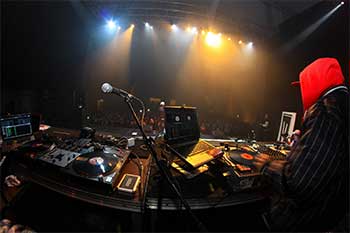
While there is a thriving C-pop market in Asia today, Hip-Hop (and Rock) are significantly less popular and in fact, Hip Hop music in mainland China was done mostly underground until a decade ago when it gained a small amount of mainstream acceptance (especially with the younger Chinese generation). Because of Hip-Hop’s inherent rebellious nature and counter-culture lyrics, this genre has taken a long time to become an accepted form of music compared to Hip-Hop in the West. Still today, the lyrics and stage antics are heavily monitored, and artists have generally come to learn which counter-culture lines they can push, and which ones will land them at grave odds with government censors (or authorities in general). Navigating these lines have been challenging, but the rise of Hip-Hop’s acceptance over the past 10 years suggests that current popular artists are becoming more successful on crafting a Hip-Hop genre that is uniquely Chinese.
Often, Chinese Hip-Hop involves remixing popular western pop songs with a more edgy hip-hop beat, changing most of the lyrics into Mandarin (or Cantonese), thereby giving Chinese fans a new sound, yet not risk using offending lyrics. A Chinese Hip-Hop artist named “Young Jack” did exactly this with Celine Dion’s song “My heart will go on”. There are however more than western remixes coming out of Chinese Hip-Hop – most artist in fact do write unique verses laid on top of unique beats – but the subject matter of these songs will still be strikingly different from western Hip-Hop.
Rock
As with Hip-Hop above, western Rock-n-Roll music has an inherent counter-culture message in most songs along with a very counter-culture image (think “sex, drugs, and Rock-n-Roll”, crazy parties, and men with long hair). These are not images which are condoned by the Chinese government and therefore, while Chinese rock may avoid these messages in the lyrics, the very nature of the sound often conjures up this rebellious nature and thus is not broadly accepted in Chinese society. For anyone puzzled by this reaction/reception, it is not unlike the way Rock-n-Roll was first received in the US and UK in the 1950’s. After all, even Elvis was filmed from the waste up during his first several TV appearances and the “long” hair of the Beetles was first ostracized by much of the US and UK public. Furthermore, the lyrics of the first generation of Rock-n-Rollers were significantly subdued in comparison to the heavier, more rebellious and controversial lyrics of rock groups in the 70’s and 80’s. This leery public reaction to rock music back then is similar to the current-day Chinese public reaction.
Yet, there are pockets in Chinese society, mainly among the younger generation, that craves the feeling that rock gives listeners and thus a growing following of rock musicians have sprung up around the country over the past 15 years. Some will say the base for mainland China’s rock music scene lies in Shanghai and Beijing, but there are pockets in Wuhan, Sichuan, Guangdong, and Shaanxi (among many other areas) that have produced influential Chinese rock bands/singers – not to mention the much more flourishing rock scene found in Hong Kong and Taiwan.
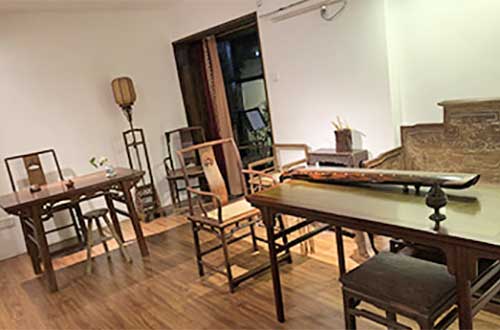 Traditional Tea Ceremony and Guqin Experience
Traditional Tea Ceremony and Guqin Experience 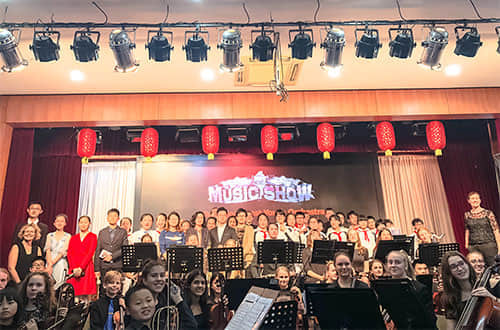 China Music Tour
China Music Tour 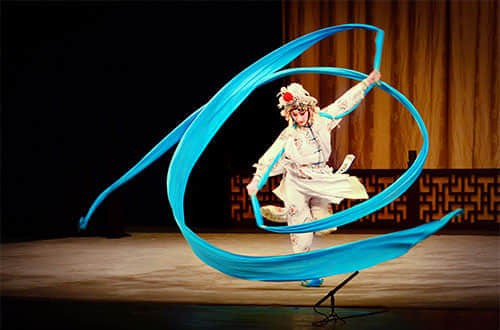 Chinese Operas
Chinese Operas 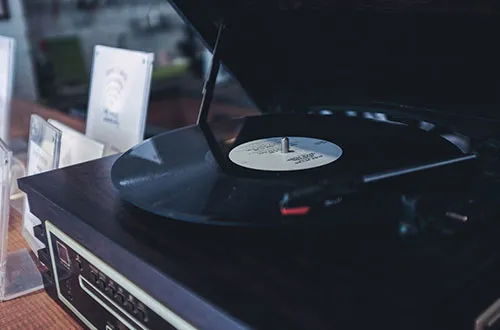 Chinese New Year Songs
Chinese New Year Songs